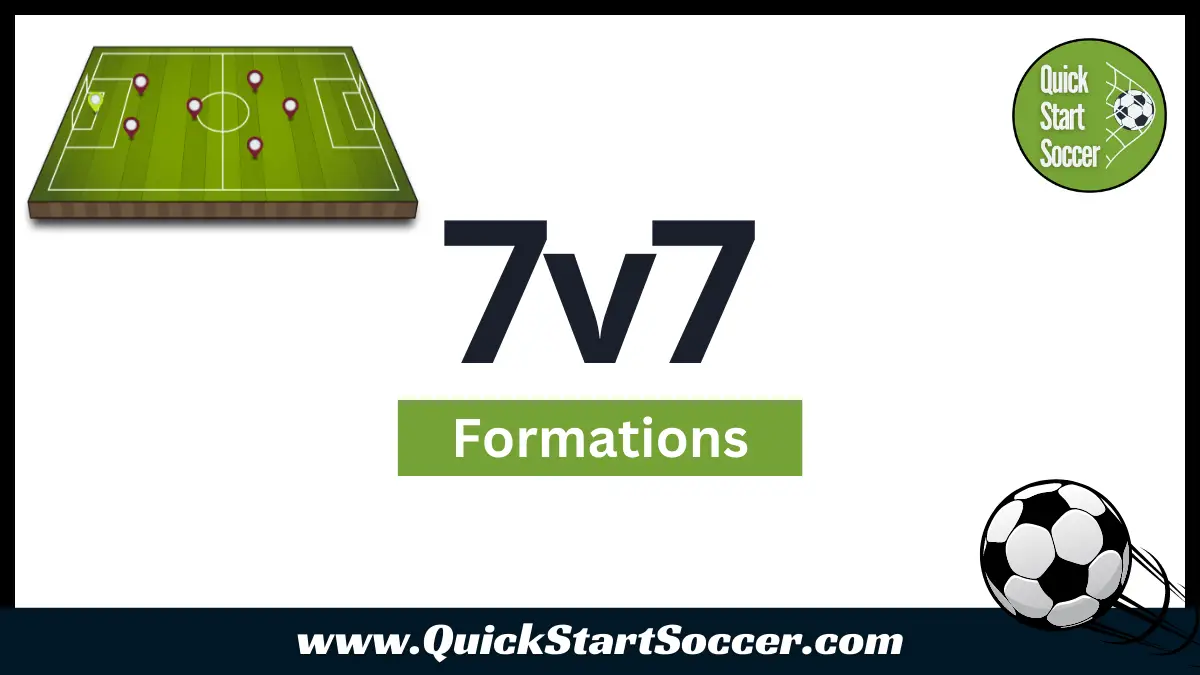Best 7v7 Soccer Formations For Your Team
7v7 games are a modern staple of youth soccer, both in the U.S.A and abroad. The small-sided format is preferred for young players because it gives children more touches on the ball and a higher frequency of decision-making opportunities. In addition, the 7v7 game is often a player’s first step into a game that looks more like adult soccer with goalkeepers, a referee, and specific player positions in defense, midfield, and attack.
Understanding the different 7v7 formations available, as well as their strengths and weaknesses, is essential knowledge for both experienced coaches and those who are new to the game. In this guide, we will show you the best 7v7 formations for your team and explain some important things about the 7v7 game, such as when children start playing 7v7, the size of a 7v7 soccer field, and the ‘build our line’ that is used in 7v7 games.
Related: 9v9 Formations
When do players start playing 7v7?
In the U.S.A, children start playing 7v7 soccer in the U9 age group (although some states have 7v7 leagues as young as U8). 7v7 is the preferred format for U9 players in the U.S.A and is seen as a good stepping stone into the 9v9 format that teams start to play at U11.
It’s worth noting that in many European countries, governing bodies have adopted even smaller-sided formats (such as 4v4 or 5v5) for these ages and now do not start playing 7v7 soccer until their players are 10,11 or even 12 years old. The thinking behind this is to provide even more touches on the ball for players, so they have a more sound technical and tactical base as they progress and continue to play the game.
How big is a 7v7 Field?
A 7v7 soccer field has the following dimensions: 35-45 yards wide and 55-65 yards long. Accept from the smaller field dimensions, a 7v7 soccer pitch looks like a regular soccer field with two penalty and goal areas, a center circle, and corner arcs in each corner. However, a notable addition to a 7v7 soccer field is the ‘build-out line’, which may be painted on the field or simply marked with cones. Learn more about Soccer Field Dimensions here.
What is a build-out line in soccer?
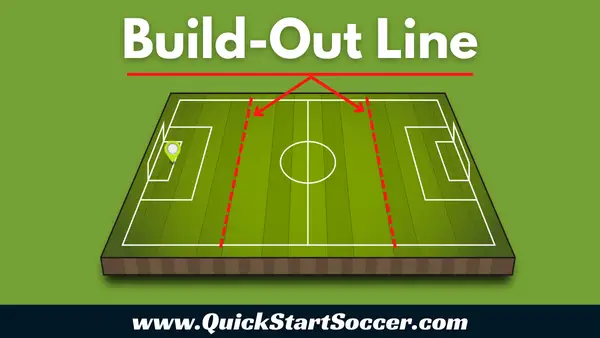
In 2016 U.S Soccer introduced the concept of a build-out line and specified its use in the 7v7 format. Essentially the build-out line is a horizontal line that goes across the field from one side to another, 14 yards away from each goal. When the defending goalkeeper has the ball in their hands or is taking a goal kick, the opposing team needs to retreat behind the build-out line and wait for the ball to be put back into play before they can apply pressure. As soon as the ball it’s kicked, rolled, or thrown by the goalkeeper, the game is live, and they can play as and move as normal.
Two additional and important things to note; (1) should the goalkeeper decide to play the ball quickly before the opposing team has retreated behind the line, play continues as normal; (2) no punting is allowed at this age, so if the goalkeeper has the ball in their hands, they must either roll, throw or drop it on the floor and kick it from the ground.
Best 7v7 Formations
Now that we’ve covered the basics of 7v7 soccer, it’s time to look at the best and most common 7v7 soccer formations.
1-2-3-1 Formation
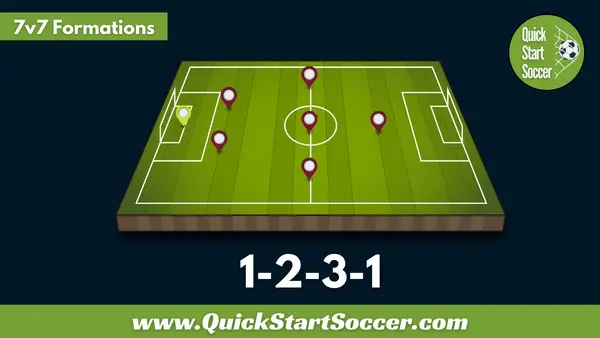
The 1-2-3-1 formation is the most popular and widely used formation in 7v7 soccer. With one goalkeeper, two central defenders, three midfielders (a left, a right, and a center), and one striker, this formation has a good spread of players across the field and provides strength in numbers in the all-important midfield area.
The clearly defined positions for all players can be helpful in developing young players’ understanding of their roles, which in turn helps with their positioning on the field. The formation also helps naturally put players in positions through which they can create diamonds and triangles as they work to keep possession of the ball and build through the thirds from defense to attack.
Although the drawbacks of this formation are few, it’s worth noting the potential for defenders to be left short-handed at the back should the midfielders not work up and down the field as they should. There can also be space in the defensive wide areas that adept attacking teams may look to exploit.
1-2-1-2-1 Formation
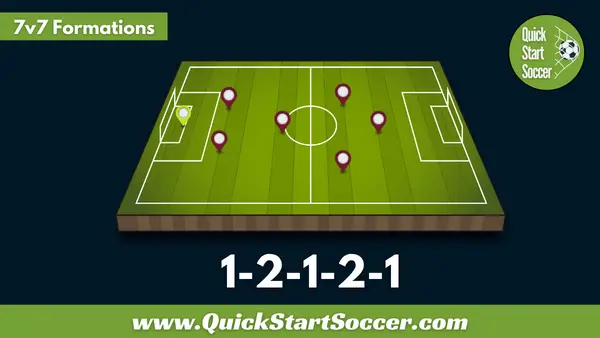
The 1-2-1-2-1 formation is remarkably similar to the 1-2-3-1. This formation, however, is even better at putting players in positions to naturally create diamonds and triangles all over the field. The main difference between this formation and the 1-2-3-1 formation is the way the three midfielders are set up. There is one deeper-lying midfielder and two more attacking midfielders further forward on either side.
This formation can give you greater strength in attack, with the two attacking midfielders working in closer conjunction with the lone striker. However, as the midfielders are a little narrower, it can leave you open to opposition attacks from wider areas. Overall though, this is another excellent option and somewhat easy-to-understand 7v7 formation for your young players to use.
1-3-1-2 Formation
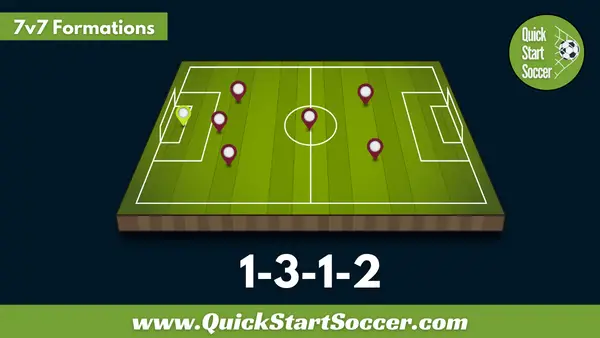
This 7v7 formation is great for those looking for a little more stability and the back. With three defenders (a left, a right, and a center), one midfielder, and two forwards, having an extra player in the back line really helps to cover all parts of the defensive third of the field. This makes it (in theory, at least) harder for your opponents to score.
The obvious drawback to this formation is the lack of numbers in midfield which could result in you inviting more attacks on your own goal overall. To combat that, it’s important that the two strikers and two outside defenders are fluid in their positions and help out in the wide midfield areas both in and out of possession of the ball.
1-3-2-1 Formation
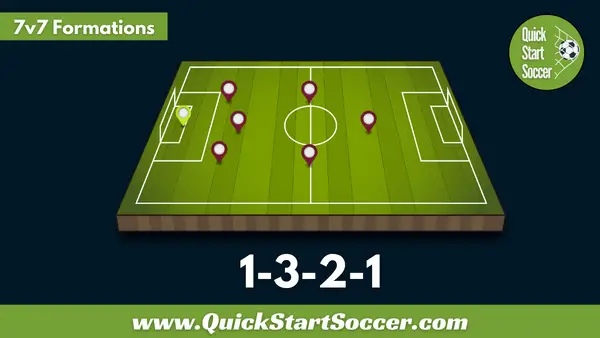
Park The Bus! The final 7v7 formation on our list is the 1-3-2-1 formation. This is undoubtedly the most defensive formation in 7v7 soccer that you can play. Like the 1-3-1-2, this formation gives you stability at the back with three defenders and strength in the midfield area with two central midfielders instead of one. This can make your team very hard to beat due to the sheer numbers you have in the central area of the field.
The downside of the 1-3-2-1 is that it doesn’t really lend itself to possession-based play once you win the ball back. It also offers you fewer options going forward with just a lone striker and no outside midfielders. Despite this, ‘parking the bus’ and playing the 1-3-2-1 can still be a good option for a team that finds itself getting consistently overwhelmed by faster, stronger players!
Wrapping Up
Thanks for reading! I hope your team has lots of success playing these different 7v7 formations. Before you go, be sure to check out our free soccer drills and our soccer positions and formation guides for more useful information you can use when planning your future training sessions.

